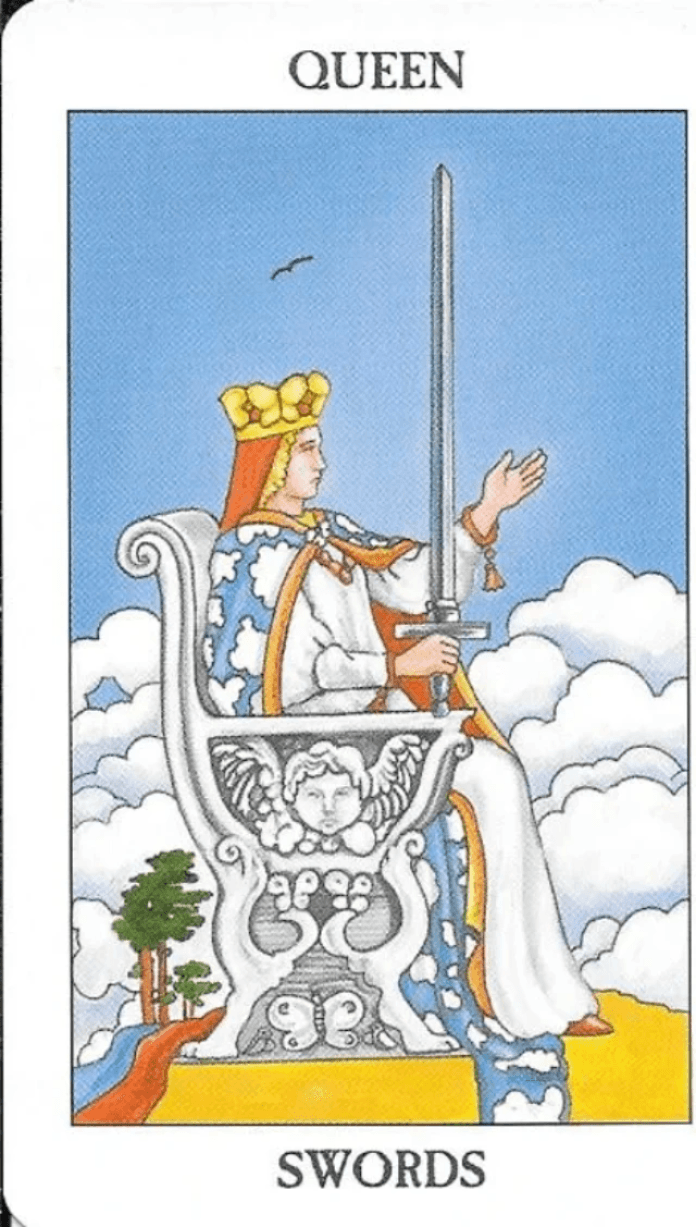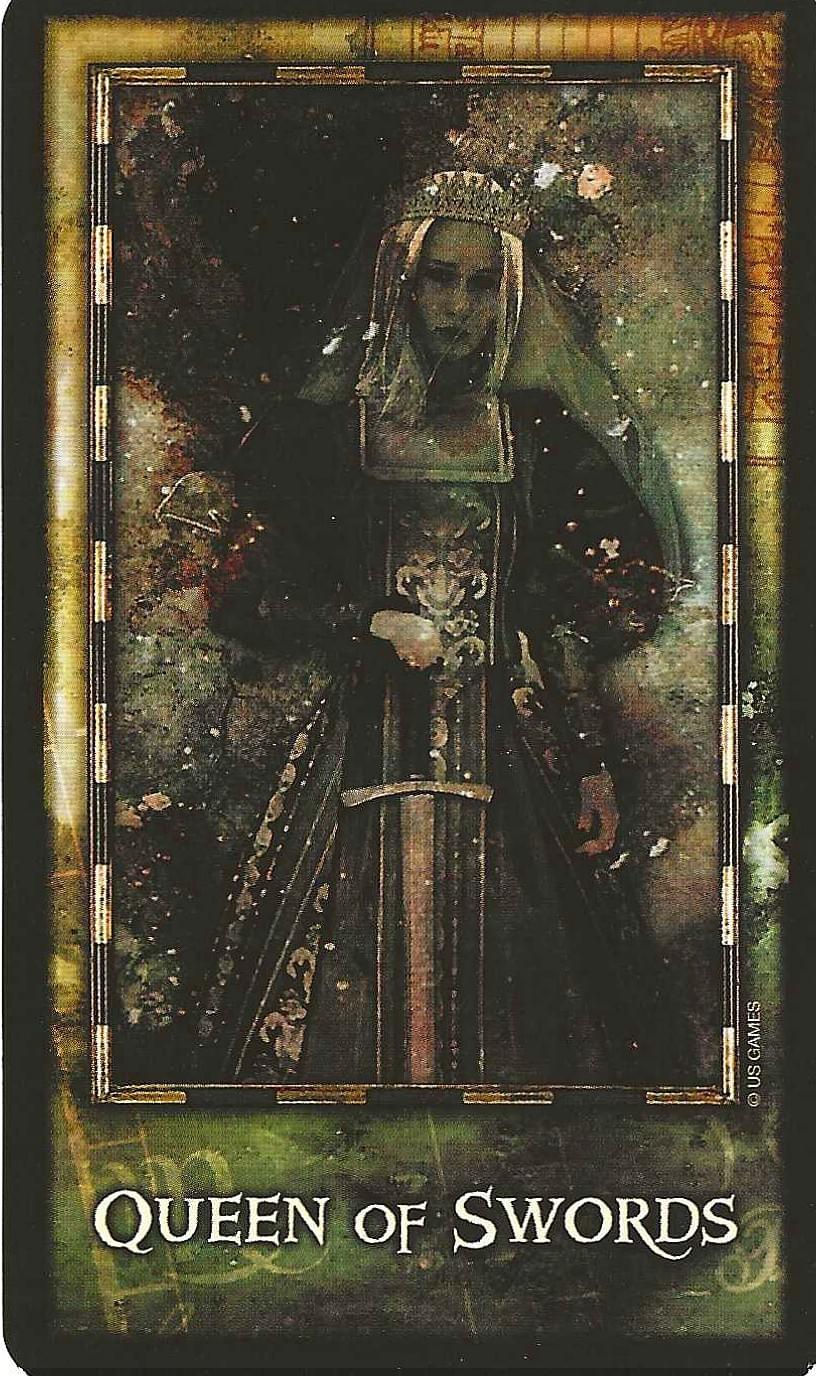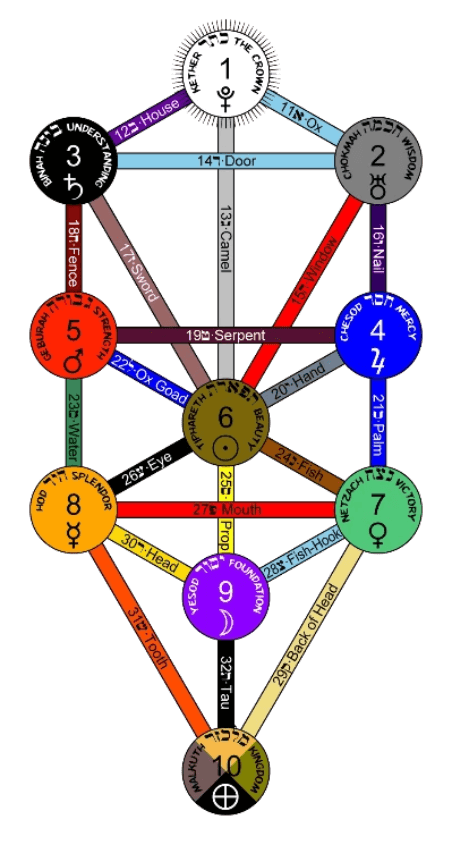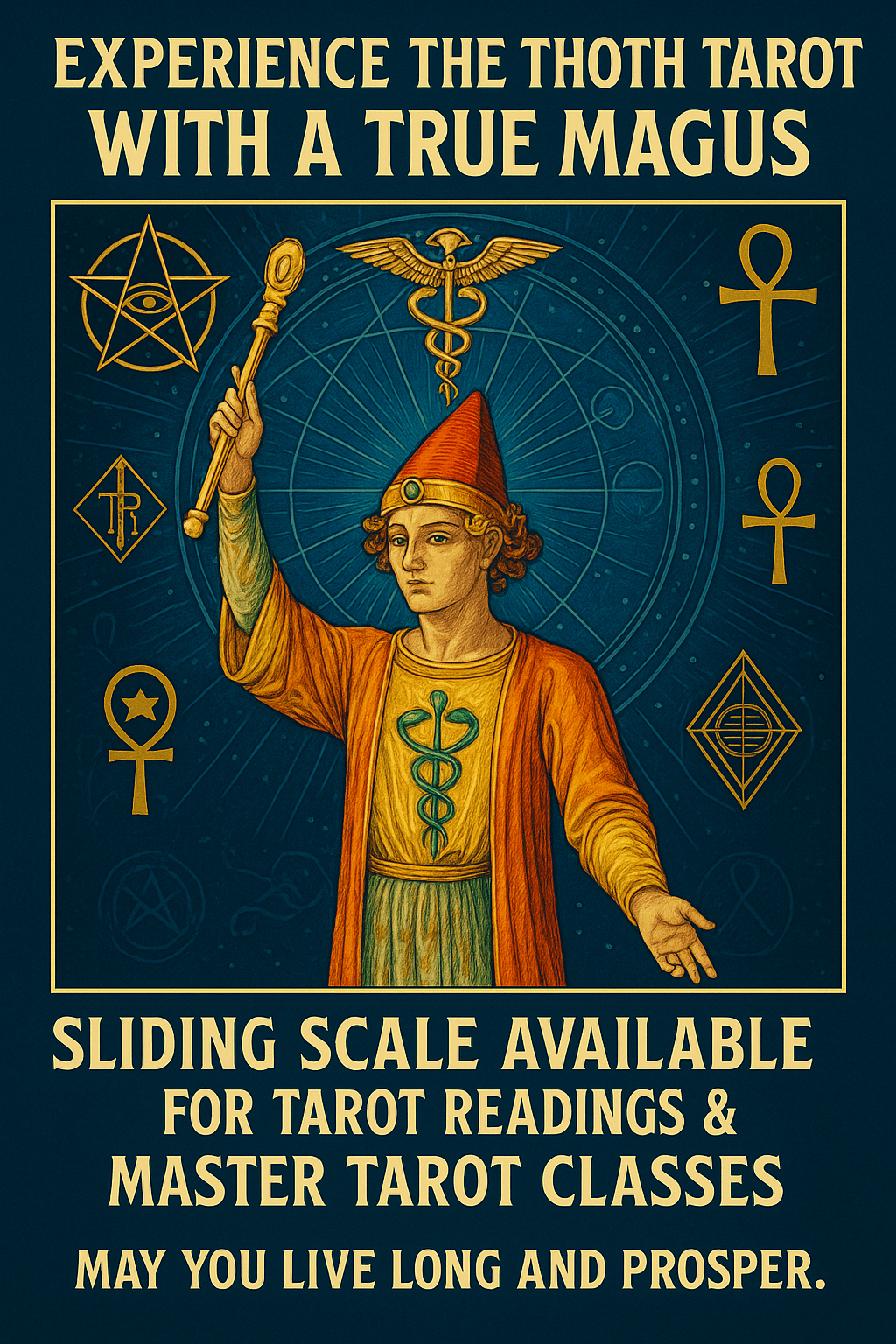#tarotqabalahtraditionalmagickelitarot2strikingly.com
Above all things, know thyself.

Archeon Tarot-Queen of Swords

Radiant: Rider-Waite-Smith Tarot- Queen of Swords
The Rider–Waite–Smith Queen of Swords and the Archeon Tarot Queen of Swords both guard the deeper Mysteries of the Qabalistic Philosophy, concealing their inner workings from the uninitiated. This veil is no accident. Arthur Edward Waite, as founder of his own occult lodge and a sworn initiate of the Hermetic Order of the Golden Dawn, was bound by oath never to reveal the secret initiatory formulae—those very processes that the later Thoth Tarot dares to display more openly. Yet, even within this veil, subtle esoteric hints remain for those with eyes to see.
In both decks, the Queen stands as a Great Sober Matriarch, larger than life—an archetype of disciplined intellect and regal authority. In the Rider–Waite–Smith card, she raises her sword in poised defense, yet her left hand extends in a gesture of welcome or parley, implying a peace obtained not by passivity, but through the severity of truth. Her throne bears a carved cherubic head—symbolic of the Divine Child or Soul—reminding the adept that she defends the higher Self within. Above and around her drift clouds and soaring birds, affirming her dominion over the airy realm of Mind. Even her cloud-like mantle evokes the mutable, shifting nature of thought itself.
Here, she is rendered as a serene yet implacable Kali-Ma figure: the one who both grants and withholds, who cuts away illusion to reveal truth. Waite, still bound by his oath of secrecy, could only gesture towards the deeper Western Hermetic Qabalah with these atmospheric symbols—leaving the initiated to read between the lines.


The Archeon Tarot -Queen of Swords
The Archeon Tarot – Queen of Swords presents a regal feminine figure as beautiful and cold as carved ice—her elegance as sharp and crystalline as the blade she wields. She is the embodiment of clarity born from detachment, a sovereign who does not allow sentiment to cloud her perception. Her insight can be searingly direct, even sarcastic, for her quest for truth is driven by an unyielding desire for purity of mind and purpose. She may signify the states of widowhood, loss, or separation, yet from these trials she distills a formidable determination and unclouded vision.
When reversed, the Queen’s clarity turns to frostbite—manifesting as intolerance, resentment, ill-temper, pettiness, cruelty, and the venom of a mind misapplied. She becomes a destroyer of trust, her words weaponized into bitterness. Yet even in this shadow form, she retains her uncanny capacity to “know what must be done” when others falter.
In her highest expression, she is the crystalline clarity of the Creatrix Mind—stripping away the illusions of the “drama queen” and the self-imposed victim narrative. Here, she resonates with the archetype of the Norse Ice Queen, a figure often accompanied by a wolf: a creature whose loyalty, intuition, and cunning mirror her own potential for great knowledge. This is the Queen who understands that wisdom is not a trophy to be hoarded, but a resource to be transmuted into abundance and sovereignty. Her ice is not cruelty—it is the diamond-hard surface beneath which the deep waters of power and knowing flow.

Freyja (or Freya) is one of the most powerful and enigmatic goddesses of the Norse pantheon, embodying love, beauty, war, sorcery, and death. She is often associated with wolves, winter, and the mysteries of Seiðr (Norse magical practices). Below are some key aspects of her characteristics and symbolism:
1. Goddess of Love and Beauty
Freyja is often compared to Aphrodite or Venus, but she is more than just a love goddess. She represents both passionate love and deeper spiritual love, making her a goddess of attraction, desire, and fertility.
2. Mistress of Seiðr (Norse Magic)
She is the foremost practitioner of Seiðr, a form of Norse magic that involves trance, shape-shifting, prophecy, and altering fate. Odin himself learned Seiðr from her, highlighting her dominance in magical arts.
3. Leader of the Valkyries & Battle Goddess
Unlike many love goddesses in other traditions, Freyja has a strong connection to war. She receives half of the fallen warriors in battle, taking them to her hall, Sessrúmnir, in Folkvangr, while Odin receives the other half in Valhalla.
4. Goddess of Death & the Underworld
Freyja’s role in choosing slain warriors links her to death and the afterlife. Her affinity for spirits and magic suggests she serves as a guide between realms.
5. Association with Wolves
Wolves, in Norse tradition, symbolize both destruction and untamed spiritual forces. Freyja, sometimes depicted with wolves, embodies the raw power of nature, the wild hunt, and the primal forces of love, war, and magic.
6. Winter and Shamanic Journeying
Freyja’s association with winter links her to the death-rebirth cycle, as winter is the time of descent into darkness before renewal. In this sense, she reflects aspects of the Underworld Goddess archetype and initiatory trials.
7. Mistress of Cats
She is often depicted riding a chariot drawn by two great cats. Cats, as liminal creatures between the seen and unseen worlds, reinforce her ties to magic and mysticism.
8. Brísingamen – Her Sacred Necklace
Freyja owns the Brísingamen, a golden necklace that represents divine radiance and power. She acquired it through a bargain with the dwarves, reinforcing her connection to wealth, desire, and magical empowerment.
9. The Vanir and Fertility
As a member of the Vanir (a race of deities associated with nature, fertility, and magic), Freyja governs abundance and prosperity.
10. Shape-shifting & Falcon Cloak
She owns a cloak of falcon feathers that allows her to shape-shift into a bird, reinforcing her role as a traveler between realms.
Conclusion: A Multifaceted Goddess
Freyja is both fierce and enchanting, embodying war and love, life and death, magic and beauty. Her connection to wolves and winter places her in a liminal space, making her a goddess of transformation and survival.

Freyja and the Queen of Swords in the Thoth Tarot: A Hermetic and Qabalistic Comparison
Freyja, the Norse goddess of love, war, sorcery, and death, aligns in fascinating ways with the Queen of Swords in the Thoth Tarot. While the Queen of Swords is often seen as an intellectual and detached figure, Crowley’s esoteric interpretation brings in the deeper elements of transformation, severance, and wisdom—qualities that resonate deeply with Freyja’s mythos.


Freyja and the Queen of Swords in the Thoth Tarot: A Hermetic and Qabalistic Comparison
Freyja, the Norse goddess of love, war, sorcery, and death, aligns in fascinating ways with the Queen of Swords in the Thoth Tarot. While the Queen of Swords is often seen as an intellectual and detached figure, Crowley’s esoteric interpretation brings in the deeper elements of transformation, severance, and wisdom—qualities that resonate deeply with Freyja’s mythos.
1. The Queen of Swords: The Severing Force of Truth
Astrological and Qabalistic Attributes
- The Queen of Swords rules over the last decan of Virgo and the first two decans of Libra, linking her to intellect, discernment, and balance.
- In the Qabalistic Tree of Life, she sits in Binah (Understanding) in Yetzirah (Formative World)—the realm of air, where ideas take shape and clarity is gained through separation.
Symbolism in the Thoth Tarot
- The Queen holds a severed head in her left hand, a stark reminder of her role as the clear-cutting force of truth and transformation.
- Her sword is pointed downward, suggesting wisdom that is directed inward, toward introspection and self-liberation.
- She is a widow, representing detachment from illusion and the ability to cut away what no longer serves.
2. Freyja: The Queen of Seiðr, Battle, and Transformation
Aspects of Freyja That Resonate with the Queen of Swords
- Seiðr & Magic: Freyja is the goddess of Norse magic (Seiðr), which involves divination, fate-weaving, and transformation—paralleling the Queen’s insight and mastery over the unseen.
- Death & the Fallen: She receives half of the slain warriors in battle, a role that mirrors the Queen of Swords’ function of judgment and discernment.
- Liberation from Illusion: Freyja is known for her autonomy, independence, and ability to navigate both war and love. Like the Queen of Swords, she is not easily deceived and wields knowledge as a weapon.
Symbols of Freyja That Reflect the Queen of Swords
- Her Falcon Cloak: Allows her to shift forms, much like the Queen of Swords' ability to transcend falsehood through perception.
- Brísingamen Necklace: A symbol of power, insight, and divine favor, much like the severed head in the Queen’s hand—both represent the wisdom that comes through trial and sacrifice.
- Association with Winter: Like the Queen of Swords, who thrives in the cold realm of air, Freyja is often linked to winter, the season of stillness, reflection, and endings.
3. The Queen of Swords and Freyja: A Hermetic View
From a Hermetic perspective, both Freyja and the Queen of Swords embody the power of Saturn in Air—the ability to cut through illusion, accept necessary endings, and move forward with clarity. This echoes the idea in Western Hermetic Qabalah that Binah (Saturn) grants understanding through separation.
Additionally, both figures share the lunar wisdom of Ishtar/Inanna, as Freyja and Ishtar are often linked. The Queen of Swords, despite her air aspect, holds a deep connection to lunar cycles and intuition, emphasizing the balance between intellect and inner knowing.
4. Final Synthesis: Freyja as a Living Archetype of the Queen of Swords
- Both serve as intermediaries between life and death, wisdom and love.
- Both rule over transformation and severance, understanding that to gain clarity, one must be willing to let go.
- Both embody a feminine force of strength, wielding intelligence, magic, and warlike prowess.
In a Tarot reading, drawing the Queen of Swords with a Norse or shamanic focus could signify a Freyja moment—a time of cutting illusions, embracing one’s independence, and claiming the wisdom gained through hardship.
For Western Hermetic Magick Ritual invocation of Freya go to and scroll down menu and click on blog page:

In the Western Hermetic Qabalah the Qabalistic Mother of Consciousness, Binah, the 3rd Sephiroth is called UNDERSTANDING and is also often called the Sanctifying Intelligence and known as the Parent of Faith.

What is often not realized is that She also represents Chronos/Saturn, who was/is considered a male aspect of the Collective Mind, known in mythology as "Grandfather Time" (before Patriarchy, she was Juno-a two-faced goddess of life and death), who is the oldest of ancient gods. We may now know him as "Father Time", but the highly restrictive nature of time, birth, aging, and death are the ultimate result of the gift of Life bestowed by the female aspect of the Divine Creative- Binah. So once again the gender of the Sephira proves to be insubstantial for complete understanding.

Juno (Time-Space and/or Life-Death)
It helps to remember that each Sephiroth has an expressive-male-state (Will-to-Force) and a receptive-female-state (Understanding that is Will-to-Form) of consciousness and that the Divine Creative is a ternary combination of Kether, Chokmah and Binah, inseparable and infinitely inexplicable. So, we can also call her "Mother Time-Space".
There is no end to the Queen of Swords comparison to the Divine Feminine of All cultures.
In Hindu mythology, she is Kali-Ma who uses her swords to slice away illusion and/or the head of the Patriarch, which we moderns now call the Military Industrial Complex, thanks to the famous speech of President Eisenhower. Hence, she is seen as a terror to the social egregore indoctrinated populace and a freer of our Souls from its "group indoctrinated mind's" putrid embrace.

Kali Ma

Adam Khadmon-The Heavenly Human
In the beginning we are the Golden Child of the Divine Creative and are called Daath-Knowledge. That identity is rarely shown on the Tree of Life, nestled as it is between Chokmah and Binah on the middle pillar (throat area of the Adam Khadmond illustration). This invisibility is because this Child of Wisdom and Understanding has all potential, allowing us to supply our own definitions of Self.

Once the Prodigal Child, who has walked down the Tree of Life to Earth, has consciously returned to the Parents (Supernal Triangle and/or Super consciousness) and claims their inheritance Daath becomes visible again and knowledge becomes manifest. There is also a lesson to remember here: to accept any definition of yourself as less than the I Am of the Divine Creative, is to become invisible to your Creatrix!

The Queen of Swords-The Sanctifying Intelligence
It is vital to understand that you are not a question in the Divine Mother’s Universal Collective Unconscious. Questions, by their very nature, are unmanifest—they are voids seeking form, empty vessels yet to be filled. You, however, are manifest. You are the living synthesis of the Divine Creative Mind: the Anima, the generative Imagination, and the Animus, the discerning Reason—joined seamlessly with the animal mind of Earth, the subconscious reservoir of instinct and survival. There is no question about it—you are meant to be exactly you.
You are the living bridge between the Created and the Divine Creative. In this role, you are not a riddle to be solved, but Knowledge itself—already known and cherished by the Divine. Your very existence is the Divine’s affirmation: you are an Answer incarnate. And as the ancient dictum commands: Above all things, know thyself. Your highest purpose is to imagine and embody the truest, noblest, and most radiant version of yourself—being you in the fullest way possible.
Here, the Queen of Swords emerges as the Sanctifying Intelligence—the Qabalistic current of “I AM.” She is the crystallized clarity of consciousness, the sharp-edged wisdom that defines, refines, and sanctifies. Your body and personality are the consecrated Child of that Divine utterance—the “Me” shaped and brought into form by the Infinite. In her hand is the sword of discernment, in her heart the law of truth; she reveals that self-realization is not a quest for answers, but the embodiment of the Answer you already are.

The Queen of Swords can also reveal a charming and engaging side—an individual of refined social grace and intuitive tact. She is at once sensitive, reflective, and adaptable, navigating conversations and relationships with an ease that makes others feel heard and valued. Her manner is rarely abrasive; she has no desire to wound or to provoke, and her instinct is to listen, weigh all sides, and seek common ground. As a consummate diplomat, she prefers harmony over discord, and will artfully defuse tension rather than inflame it.
Yet, beneath this velvet diplomacy lies a spine of steel. She does not “suffer fools” lightly, and while she will give others the courtesy of her patience, she will not allow herself to be deceived, belittled, or wronged without reply. Should such a boundary be crossed, the transformation can be startling—the measured tone gives way to a decisive, even fierce, response. In that moment, her sword is unsheathed, and the sharp edge of her intellect and moral conviction is felt with full force.
Thus, the Queen of Swords is not only the aloof arbiter of truth; she is also the cultivated hostess of discourse and mutual respect. Her wisdom lies in knowing when to compromise and when to stand unmovable—balancing receptivity with the capacity to cut through falsehood in a single stroke.

Qabalistic Tarot Personality Birth Wheel
This personality's life is drawn in contradictory directions: Family and home are all important to her as she derives strength from her family. Yet, her interpersonal abilities bring her to the forefront of social and career situations, and she must delicately balance the two worlds.
In the Western Hermetic Qabalistic Tarot, such as the Thoth Tarot Deck, the Queen of Swords is traditionally associated with the zodiac sign of Libra. The Thoth Tarot often links Court Cards with astrological signs in a particular decan system, and the Queen of Swords rules the last decan of Virgo (20°-30°) and the first two decans of Libra (0°-20°).

The Queen of Swords: Astrological Decans and Esoteric Meaning
The Queen of Swords in the Thoth Tarot rules the last decan of Virgo (20°-30°) and the first two decans of Libra (0°-20°). This placement reveals a fascinating interplay between Mercurial intellect (Virgo) and Venusian balance (Libra), filtered through the element of Air, manifesting as clarity, discernment, and decisive detachment.
1. Virgo (20°-30°) – The Analytical Threshold
The Queen of Swords begins her rule in the last decan of Virgo, ruled by Mercury. This brings an acute intellectual perception, keen observation, and the ability to analyze truth from falsehood.
Virgo’s Influence on the Queen of Swords:
- Virgo is ruled by Mercury, the planet of intellect, communication, and precise thinking.
- The last decan of Virgo is ruled by Venus, adding an element of aesthetic discernment and fairness.
- This results in a mind that is both logical and refined, able to cut through deception with precision.
Symbolic Alignment with the Queen of Swords:
- The severed head in her hand symbolizes Mercurial detachment—she discerns what must be removed for clarity.
- Her sword is downward-pointed, showing that her mind works inwardly and logically rather than impulsively.
- Virgo’s methodical, detail-oriented nature gives the Queen her sharp mind and intolerance for deception.
This Virgoan side of the Queen of Swords represents meticulous thought, perfectionism, and the ability to see hidden details, much like Freyja’s Seiðr magic, which required precise knowledge of fate and hidden forces.
2. Libra (0°-20°) – The Balance of Truth
As the Queen moves into Libra’s first two decans, her energy shifts from pure analysis to discernment and justice. Libra is ruled by Venus, bringing a need for harmony, diplomacy, and fairness, yet she remains a figure of detachment and objectivity.
Libra’s Influence on the Queen of Swords:
- Libra is ruled by Venus, but its first decan (0°-10°) is influenced by the Moon, which grants emotional intelligence and intuition.
- The second decan of Libra (10°-20°) is ruled by Saturn, introducing discipline, seriousness, and karmic judgment.
- Libra’s association with justice and equilibrium reinforces the Queen’s role as a seeker of truth.
Symbolic Alignment with the Queen of Swords:
- Libra’s influence softens the Queen’s Virgoan precision, making her wise and just rather than cold and cutting.
- The balance of the Moon (intuition) and Saturn (strict logic) creates a mature and impartial intelligence.
- Libra’s energy makes her a fair judge, reinforcing her association with Saturnian karma and detachment from personal emotions.
In essence, Virgo sharpens her mind, while Libra gives her the ability to weigh and judge fairly—an essential combination for truth-seekers and those who cut through illusion.
3. The Synthesis: Hermetic and Qabalistic Insights
In Western Hermetic Qabalah, the Queen of Swords corresponds to Binah (Understanding) in Yetzirah (the Formative World). She embodies the wisdom that arises from the structure of intellect, merging the merciful insight of Venus (Libra) with the cutting discernment of Mercury (Virgo).
- Binah (Saturn) grants her the ability to perceive structure and limitation—hence her ability to sever falsehood.
- Yetzirah (the Air World) places her in a realm of ideas, communication, and higher thought.
- The Queen’s sword is her power of Logos, mirroring the Norse Ginnungagap—the cosmic void where wisdom and order emerge from chaos.
4. Queen of Swords and Freyja: Astrological Parallels
- Freyja’s Seiðr magic, like Virgo’s analytical mind, required intricate knowledge of the hidden forces of fate.
- As a chooser of the slain, Freyja embodies Libra’s weighing of souls, justice, and balance.
- Her falcon cloak is an air-element symbol, linking her to Yetzirah and the Queen’s intellectual power.
Thus, Freyja and the Queen of Swords share the same archetypal essence—a goddess of wisdom, war, magic, and decisive judgment.
Conclusion: The Queen of Swords as a Bridge Between Virgo and Libra
- Virgo (Mercury) gives her the ability to analyze and perceive truth with clarity.
- Libra (Venus, Moon, and Saturn) grants her balance, fairness, and the ability to judge wisely.
- Hermetically, she embodies Binah in Yetzirah, the airborne wisdom that cuts illusion from reality.
This makes her one of the most insightful and powerful cards in the Thoth Tarot, perfectly aligned with Freyja’s role as a sovereign figure of war, wisdom, and magical initiation.

Thoth-Queen of Swords
In this system, the Queen of Swords expresses the intellect and rationality of air signs, especially Libra, known for its focus on balance, justice, and relationships. Hence, the Libra scale like image of her two arms balancing the sword and mask/head of the patriarch while high in the clouds of the sky. Libra’s ruling planet is Venus, which adds qualities of refinement and fairness to the card.
If you're exploring its planetary associations, while the zodiac link is to Libra, the planetary connection (due to its zodiac sign) would relate to Venus. However, in Crowley's system, the elemental nature of Air would typically connect with Mercury as well, emphasizing communication and logic.
When the Queen of Swords is thrown during a reading:
- The querent desires to discard, pretense, masks, roles, or defenses that hide their true self.
- One Wishes to develop or is developing intellectual thinking.
- Is undergoing a sense of resolution and commitment.
- Is experiencing intellectual maturity and is experiencing well-tuned mental facilities. Sharp of wit.
- Experiencing the Wisdom generated by sorrow.
- Finding Wisdom through the acceptance of Pain with courage, and honesty.
- Strong willed and determined, this woman will and can bear whatever life presents her with.
- Deep comprehension of frightening truths.
- Able to think the unthinkable and give expression to the unspeakable.
- A professional, who can handle situations capably, quickly, and efficiently.
If reversed, it implies:
- Calculating coolness.
- Insuperable distance.
- Disingenuousness.
Thank you for your interest, comments, and supportive donations. May you live long and prosper.

🔮 Experience the Thoth Tarot with a True Magus 🔮
Step beyond the fortune-teller’s table and enter the realm of true Hermetic insight. My Tarot readings are not mere “card pulls”—they are an initiation into the deep symbolism of the Thoth Tarot, infused with the wisdom of the Western Hermetic Qabalah. As a practicing Magus, I do not simply “interpret” cards; I unlock their multidimensional meaning, bridging ancient Mystery teachings with your present life path.
A Magus brings more than intuition—
I bring the discipline of the Qabalah, the precision of astrology, the resonance of gematria, and the keys of the Major Arcana as living archetypes. With this synthesis, your reading becomes a personal map of transformation, revealing not just what is unfolding, but why—and how you can consciously shape the outcome.
Master Tarot Classes are also available for those ready to deepen their own skill and understanding. These private sessions blend practical card technique with the profound esoteric framework of the Thoth system—training you not just to read cards, but to wield them as magical tools of self-mastery.
💠 Sliding Scale Available – I believe wisdom should not be withheld for lack of funds. For both Tarot readings and Master Tarot Classes, a sliding scale is available to those who are financially challenged. Your journey toward knowledge should be open, no matter your present means.
🌟 Whether you seek clarity for today, transformation for your life, or mastery of the Tarot itself—let us walk the Path of the Magus together.
May you live long and prosper.
3 Western Hermetic Magick and Tarot Sites-Helping people become more magic and less tragic since 2010.
Traditional Tarot Card Comparisons blog.
Home page, Tarot Store, Master Thoth Tarot classes and nontraditional Tarot Card Comparisons with Thoth Tarot.
Western Hermetic Magick ritual and invocation site and blog.

